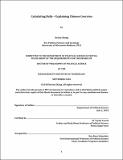Calculating bully : explaining Chinese coercion
Author(s)
Zhang, Ketian.
Download1121181904-MIT.pdf (9.141Mb)
Alternative title
Explaining Chinese coercion
Other Contributors
Massachusetts Institute of Technology. Department of Political Science.
Advisor
M. Taylor Fravel.
Terms of use
Metadata
Show full item recordAbstract
Since 1990, China has used coercion for territorial disputes, foreign arms sales to Taiwan, and foreign leaders' meetings with the Dalai Lama, despite adverse implications for its international image. China is also curiously selective in the timing, target, and tools of coercion: most cases of Chinese coercion are not military coercion, nor does China use coercion against all states that pose the same threats to its national security. The question regarding China's coercion patterns -- crucial for the prospect of peace and stability in the Asia-Pacific region and critical for understanding states' use of coercion -- has not been systematically answered. My dissertation therefore examines when, why and how China attempts to coerce states over perceived threats to its national security. This question entails two parts: 1) when and why does China choose coercion, and 2) if coercion is chosen, what tools does China utilize? I explain Chinese coercion with the cost balancing theory -- and test it against China's diplomacy. I employ qualitative methods such as process tracing and congruence testing, leveraging on primary Chinese documents and interviews with officials, government policy analysts, and scholars. My dissertation project conducts congruence tests of the macro trends of Chinese coercion while employing process tracing on specific cases of Chinese coercion. For temporal variation, I examine cases in which for the same country that is a potential target for coercion, when China coerces that country and when it refrains from coercion. For cross-national variation, I analyze cases in which for the same period and among comparable countries, China coerces some but not others. Contrary to conventional wisdom and in contrast with historical rising powers, China is a cautious bully, does not coerce frequently, and uses military coercion less when it becomes stronger, resorting mostly to non-militarized tools. In short, states' decision to coerce and choices over coercive tools cannot be simply explained by the power variable. I identify the centrality of the reputation for resolve and economic vulnerability in states' calculation of coercion. States coerce one target to deter others -- "killing the chicken to scare the monkey."
Description
This electronic version was submitted by the student author. The certified thesis is available in the Institute Archives and Special Collections. Thesis: Ph. D., Massachusetts Institute of Technology, Department of Political Science, 2018 Cataloged from student-submitted PDF version of thesis. Includes bibliographical references (pages 545-562).
Date issued
2018Department
Massachusetts Institute of Technology. Department of Political SciencePublisher
Massachusetts Institute of Technology
Keywords
Political Science.